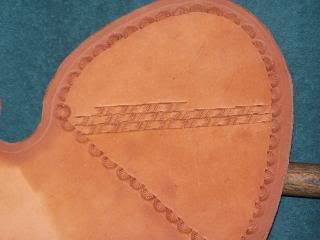This is overall a good how-to. I would only offer a couple of alternative suggestions.
I would suggest manila file folders for making patterns. The existing fold can be used for your centerline. Most holster patterns are at least partly symmetrical, some fully. Folding and cutting both sides at once helps in keeping both sides the same.
Most professionals will glue the mainseam before stitching. This is easy to do and results in a stronger seam with a more finished looking edge that will often look like one single piece of leather.
You can certainly dye after the main seam has been glued/stitched and sanded. It's a good idea to clean the surfaces with alcohol to remove any contaminates like wax and skin oils. If you use a stitching pony to do your stitching, wax is not really an issue. One advantage of dying after stitching the main seam is that the holster can be wet formed while the dye is drying. I do this by inserting the handgun in a heavy ziplock bag and then into the holster while it dries overnight.
Dampening the leather for tooling, called "casing" should be done a little differently. You do not have to soak it but dampen it well. Allow it to dry until the surface is turning to its original color. It should still feel cool and slightly damp. This may be best done overnight in a plastic bag. Properly cased, you should not have to re-dampen the leather before your stamping is done unless you're doing extensive tooling of a big gunbelt. The leather shouldn't look damp like it does in this pic:

You should not have to strike the stamp more than once or twice to make a good impression. Professional grade stamps will have a very sharp end that your mallet or maul should grab and avoid glancing off. Stamps from Tandy will need to be filed flat.
Quote:
|
After the leather edges are straight, the leather will be slightly beveled, called "skiving".
|
Not to nitpick but that's not skiving. Skiving is thinning the leather, such as at the buckle end of a belt or at the ends of a belt loop. Beveling the edges is a completely different operation utilizing different tools. Although you can bevel edges with a skiving knife, you can't skive with an edge beveler. Personally, I prefer Bissonnette style edge bevelers from Barry King. Along with their stamps and tapered head mauls.
Quote:
|
The "Cowboy Floral", stampings and carvings are much too gaudy (and feminine), for my conservative tastes.
|
This is certainly debatable. I wouldn't call any of it "feminine" but I understand that some people don't like it.